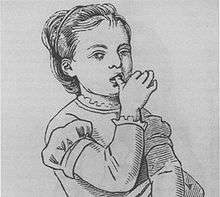Bad habit
A bad habit is a negative behaviour pattern. Common examples include: procrastination, overspending and nail-biting[2]

Development
There is a theory that it takes an average of 66 days to break a habit. The amount of time it takes to break a habit is generally between 18 and 254 days. This should often be repeated once or maybe twice depending on what the habit is, something small like chewing fingernail should only have to be done once. Larger habits like smoking should be repeated at twice but every one is different so it could be less.[3] There are sources that phrase the breaking of bad habits under habit-formation and that an individual acquires a new habit within 66 days.[4][5] A study found that this process is marked by an asymptomatic increase of the behavior, with the initial acceleration slowing to a plateau after the said time period.[5] There are several variations regarding the period of development. For instance, a source stated that breaking a bad habit or changing an unhealthy behavioral pattern such as smoking takes 90 days while forming a new habit that stick requires 66 days.[6]
Will and intention
A key factor in distinguishing a bad habit from an addiction or mental disease is the element of willpower. If a person still seems to have control over the behavior then it is just a habit.[7] Good intentions are able to override the negative effect of bad habits but their effect seems to be independent and additive — the bad habits remain but are subdued rather than cancelled.[8]
Prevention
The best time to correct a bad habit is immediately, before it becomes established. So, bad habits are best prevented from developing in childhood.[9]
Cure
There are many techniques for removing bad habits once they have become established. One good one is to go for between 21 and 28 days try as hard as possible not to give in to the habit then rewarding yourself at the end of it. Then try to go a week, if the habit remains repeat the process, this method is proven to have a high success rate.[10]
References
- M. S. Muthu, M. Sivakumar (2009), "Oral Habits", Paediatric Dentistry: Principles and Practice, Elsevier, p. 320, ISBN 9788131210581
- Suzanne LeVert, Gary R. McClain (2001). The Complete Idiot's Guide to Breaking Bad Habits. Alpha Books. ISBN 0028639863.
- Lally Phillippa (2009). "How are habits formed: Modelling habit formation in the real world". European Journal of Social Psychology. 40 (6): 998–1009. doi:10.1002/ejsp.674. hdl:10400.12/3364.
- Dean, Jeremy (2013). Making habits Breaking habits. London: Oneworld. pp. 6–7. ISBN 9781851689897.
- "Making health habitual: The psychology of 'habit-formation' and general practice" (PDF). British Journal of General Practice. December 2012. Retrieved 2018-12-10.
- Nash, Joyce (2011). Lose Weight, Live Healthy: A Complete Guide to Designing Your Own Weight Loss Program. Boulder, CO: Bulls Publishing Company. p. 51. ISBN 9781936693146.
- Mariana Valverde (1998). "Disease or Habit? Alcoholism and the Exercise of Freedom". Diseases of the Will: Alcohol and the Dilemmas of Freedom. ISBN 0521644690.
- Bas Verplanken, Suzanne Faes (21 Jun 1999), "Good intentions, bad habits, and effects of forming implementation intentions on healthy eating", European Journal of Social Psychology, 29 (5–6): 591–604, doi:10.1002/(SICI)1099-0992(199908/09)29:5/6<591::AID-EJSP948>3.0.CO;2-H
- Bill Borcherdt (1996). Making Families Work and What to Do When They Don't. Haworth Press. pp. 172. ISBN 0789000733.
- Herbert Fensterheim, Jean Baer (1975). Don't Say Yes When You Want to Say No. Dell. ISBN 0440154138.